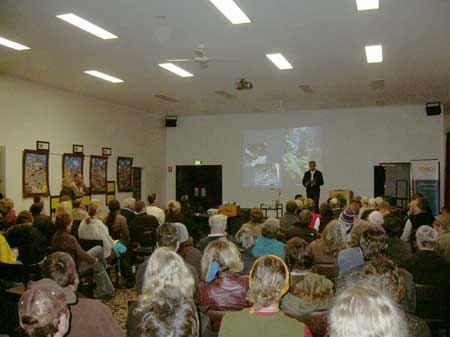

July 1, 2006: Over 150 people pack into the Luman Christi School in Churchill for a Strzelecki Forest Forum. The audience was given a detailed history of the Cores and Links Reserve proposal. Negotiations are currently occurring between Hancock and the State Government for a buy back of 8500 hectares of land including 2400 hectares of supposed hardwood plantations/native forest. For map see here.
South Gippsland Mirror 28/6/06
Eleventh hour call to save Strzelecki forests
TO HEIGHTEN community awareness of the perceived threat from logging to the Cores and Links area of the Strzelecki Ranges, the Strzelecki Forests Community Group is calling a public meeting this Saturday, July 1.
“The meeting will bring the community up to date on current negotiations and outline the history of the Strzelecki Cores and Links proposal, which aims to protect the remnant wet and cool temperate rainforests of the Strzeleckis, once the tallest forests in the world,” said Chair of Strzelecki Forests Community Group, John Gunson.
The community, the Strzelecki timber company Grand Ridge Plantations and the Trust for Nature are currently in negotiations with the Victorian Government to buy back the key biodiversity areas of the Strzelecki Ranges – the Cores and Links.
“Time is running out to save sites of the highest conservation significance in the Strzelecki Ranges. A logging moratorium ends on June 30 in the 8,400 ha of proposed reserves known as the Cores and Links, which will link the Gunyah Rainforest Reserve near Foster to Tarra Bulga National Park.
The community has requested the government help save these sites of highest conservation significance without the intrusion of a proposed one-off logging,” said Mr Gunson.
Geoff Fraser, a spokesman for Environment Minister John Thwaites, said detailed discussions on the Cores and Links were in progress. “It’s a complex issue, which is why it is taking so long [to reach a resolution],” he said. “No money was set aside [for a buyback] in the Budget, but it doesn’t mean that money won’t be available.” Mr Fraser said the government was aware of the expiry of the moratorium and was hoping that Grand Ridge Plantations would give an undertaking that it would not log the Cores and Links.
General Manager of Grand Ridge Plantations, Owen Trumper, confirmed that a voluntary moratorium would end on June 30. “The original moratorium was self imposed in 2001 for an unspecified time to allow the community and Grand Ridge Plantations (GRP) to best plan future harvesting and land use strategies to protect those values identified in the Cores and Links Report which was published in 2001 by Bios Research Consultants,” explained Mr Trumper.
“In October 2004, GRP signed a Memorandum of Understanding (MoU) with the Trust for Nature and The Nature Conservancy. This memorandum of understanding was an agreement to work together to protect the biodiversity values of the Cores and Links as well as realise the commercial imperatives of GRP. The MoU included a written moratorium on harvesting within the Cores and Links to the end of October 2005.
“In September 2005, GRP verbally committed to extend the moratorium to June 30, 2006, to allow more time for the MoU parties to come to agreement on the future of the Cores and Links, in particular some form of possible compensation/purchase agreement between the three parties.” Mr Trumper said that Grand Ridge Plantations was currently involved in discussions with numerous parties, including community representatives, non-government organisations, Trust for Nature, The Nature Conservancy and others.
“The progress is encouraging, but we have a lot more to talk about in the weeks to come,” he said. “I do not want to prejudge the possible outcome of ongoing discussions, but as we have stated publicly, if the situation remains the same, GRP will at some time have to access fibre from some of the plantations within the Cores and Links. However, we have more to talk about before any harvesting will occur.”
Mr Gunson said that the State Government’s involvement would enable it to fulfil the commitment it made in the document “Our Natural Assets: Valuing Victoria’s Natural Environment” to full protection of all conservation areas in the Strzelecki Ranges. He said that only two per cent of the bioregion was protected in permanent reserves, the lowest of any forest region in Victoria. Even with the proposed Cores and Links reserves, less than five per cent will be protected.
“There is now a chance to protect sites of national and state significance, with over 200 plant and 70 animal species, many of which are rare and threatened, including the only relic population of Koala in Victoria and South Australia. The best remaining areas of these magnificent forests must not be lost,” said Mr Gunson.
“Anybody that dreams of restoring the great forests of the Strzelecki Ranges should be with us on July 1 in Churchill.” The public meeting will be held at the Luman Christi Primary School Meeting Hall, 35 Williams Avenue, Churchill at 11 a.m. on Saturday, July 1.
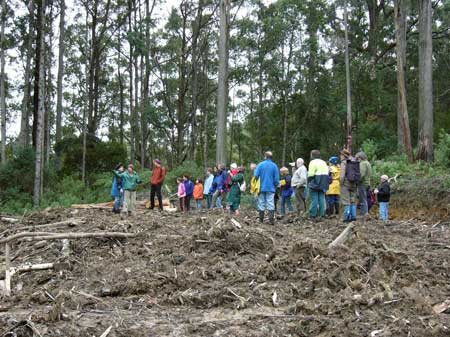
July 1 2006: Strzelecki Ranges/Morwell River East Branch - Parish of Wonyip. After the community forum, about 30 people attended a forest tour into the Strzelecki Ranges. Here the tour is looking at issues surrounding cool temperate rainforest buffers.
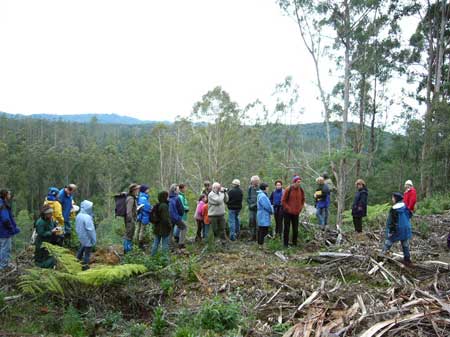
Ditto

July 1 2006: Strzelecki Ranges/College Creek - Parish of Jumbuk. Entering the College Creek catchment to look at threats to cool temperate rainforest. College Creek lies inside the Cores and Links Reserve. The Reserve is approximately 8500 hectares in size. Hancock are planning to log almost a quarter of this reserve in the next few years. Logging could commence after July 1 2006.
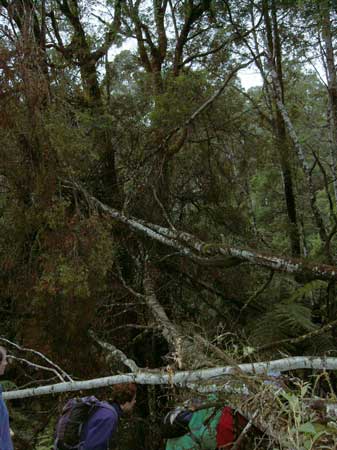
July 1 2006: Inappropriate buffers on Myrtle Beech trees in cool temperate rainforest in College Creek. Here is an example of Silverv Wattle falling into Beech tree, leaving the Beech susceptible to the disease Myrtle Wilt, which enters through wounds in trees.
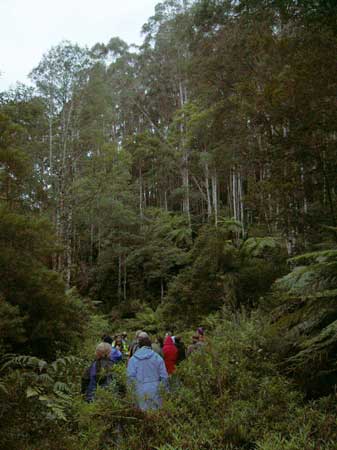
July 1 2006: Walking the buffer of the College Creek cool temperate rainforest on land leased under the 1961 and 1966 Wood Pulp Agreements. July 1 2006: The eucalypt forest in this photo will be logged with the retention of only 20 metre buffers on cool temperate rainforest. Such buffers would be a breach of the Code of Forest Practice if this site was located on "public land".
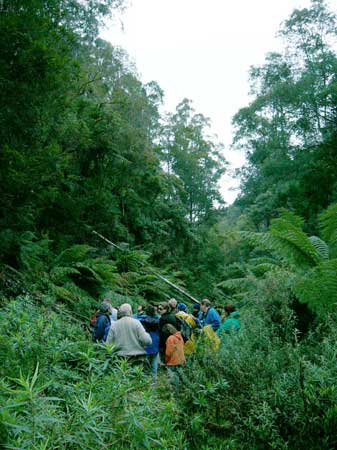
July 1 2006: College Creek rainforest buffer
Hancock Victorian Plantations Pty Ltd
PEER REVIEW OF PROPOSED RAINFOREST BEST MANAGEMENT PRACTICE
OCTOBER 2005 1
Terry Walshe 1 and David Cameron 2
EXECUTIVE SUMMARY
The brief for the conduct of this peer review requires a critique of the BMP with particular empahasis on the Rationale and Operating Standard for the protection of rainforest. More specifically, the brief requests:
*Examination of the ecological basis of the Rationale, in particular the description of the ecological processes for Cool Temperate Rainforest and Warm Temperate Rainforest and the analysis of elements of the risk profile.
*Comment on the strengths of weaknesses of the proposed protection measures, in particular the extent of buffering from a risk analysis perspective.
Central to this review is assessment of the extent to which the Company's proposed BMP is consistent with Principle 9 of the Forest Stewardship Council's Interim Standard for Assessing Forest Management in Australia. Rainforests occurring on HVP lands are considered 'high conservation value forests' under Principle 9 of the Interim Standard, which states: Management activities in high conservation value forests shall maintain or enhance the attributes which define such forests. Decisions regarding high conservation value forests shall always be considered in the context of a precautionary approach.
Although it includes no comment on the need for a precautionary approach, the intent of Principle 9 is essentially preserved in the goal of the Company's proposed BMP, which states: Protection measures will be developed to manage the risk profile for rainforest on Company land with the aim of ensuring no net loss in extent and quality of rainforest, consistent with Victoria's Native Vegetation Framework (emphasis added).
We saw the central task of our review to be assessment of the internal consistency of the BMP's Rationale and protection measures against Principle 9 and the Company's stated goal.
In general, we consider the BMP Rationale does a competent job in identifying hazards. We are less convinced of the arguements advanced in the Rationale regarding the magnitude of risk some of these hazards pose, and the associated imperative to manage those risks. In particular, we regarded the treatment of risks posed by weed invasion, buffer disturbances and edge effects, Myrtle Wilt, and wildfire to be deficient.
In relation to a goal of 'ensuring no net loss in extent and quality', the proposed BMP implicitly asserts that 20m (for locally and regionally significant rainforest) and 40m buffer widths (for state significant rainforest) will result in:
*No net increase in the incidence of weeds
*No net attrition in the viability of rainforest species through microclimatic stress beyond background levels
*No net increase in the incidence of Myrtle Wilt beyond background levels
*No net increase in the risk of fire beyond background levels
Our view is that, although scientific uncertainty constrains definitive rebuttal of these assertions, it is highly unlikely that proposed BMP protection measures will prove consistent with the Company goal. When a strict requirement for a precautionary approach is invoked, we consider buffer widths proposed in the BMP to be plainly inappropriate.
We draw the following conclusions in the context of Principle 9 of the Forest Stewardship Council's Interim Standard:
1. The Company's proposed protection measures for locally significant Cool Temperate Rainforest fall marginally within plausible bounds of scientific uncertainty for a goal of 'no net loss in extent and quality'. However, where a precautionary approach is stipulated, we regard protection measures to be inadequate.
2. If the requirement for a precautionary approach were to be relaxed, we consider specification of performance criteria and a rigorous monitoring program are needed in key areas of scientific uncertainty.
3. Protection measures for nationally, state and regionally significant rainforest are inadequate.
4. The proposal of no buffer for riparian stands of warm temperate rainforest is inadequate.
5. The field method for determining the boundary of Warm Temperate Rainforest on Company land requires further work.
We consider the BMP could be improved through adoption of the following recommendations: Include 'promote post-wildfire recovery' as a goal, and provide substance to the goal through stipulation of larger buffers around core rainforest, (e.g. at the confluence of two second-order or higher streams).
*Include 'contribute to prevention of Myrtle Wilt epidemic' as a goal, and provide substance to the goal through stipulation of larger buffers on all non-linear (>40m wide) Nothofagus-dominated stands.
*Monitor performance criteria describing thresholds for
-Weed invasion
-Abiotic microclimatic variables and the ecological impact
-Buffer disturbance
-The incidence of Myrtle Wilt
*Test the effectiveness of buffers as a risk management strategy for fire by monitoring fuel loads and fuel moisture in buffers or varying widths and varying stand age.
*Avoid exposure of more than one side of a rainforest patch to edge effects within any 5 year period through inclusion of a strict spatial constraint to this effect in harvesting scheduling.